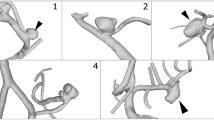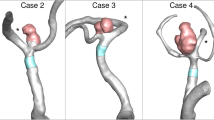Abstract
Intracranial aneurysms (IAs) occur in around 3% of the entire population. IA rupture is responsible for the most devastating type of hemorrhagic strokes, with high fatality and disability rates as well as healthcare costs. With increasing detection of unruptured aneurysms, clinicians are routinely faced with the dilemma whether to treat IA patients and how to best treat them. Hemodynamic and morphological characteristics are increasingly considered in aneurysm rupture risk assessment and treatment planning, but currently no computational tools allow routine integration of flow visualization and quantitation of these parameters in clinical workflow. In this paper, we introduce AView, a prototype of a clinician-oriented, integrated computation tool for aneurysm hemodynamics, morphology, and risk and data management to aid in treatment decisions and treatment planning in or near the procedure room. Specifically, we describe how we have designed the AView structure from the end-user’s point of view, performed a pilot study and gathered clinical feedback. The positive results demonstrate AView’s potential clinical value on enhancing aneurysm treatment decision and treatment planning.









Similar content being viewed by others
References
Antiga, L., B. Ene-Iordache, L. Caverni, G. P. Cornalba, and A. Remuzzi. Geometric reconstruction for computational mesh generation of arterial bifurcations from ct angiography. Comput. Med. Imaging Graph. 26:227–235, 2002.
Antiga, L., M. Piccinelli, L. Botti, B. Ene-Iordache, A. Remuzzi, and D. A. Steinman. An image-based modeling framework for patient-specific computational hemodynamics. Med. Biol. Eng. Comput. 46:1097–1112, 2008.
Botti, L., K. V. Canneyt, R. Kaminsky, T. Claessens, R. Planken, P. Verdonck, et al. Numerical evaluation and experimental validation of pressure drops across a patient-specific model of vascular access for hemodialysis. Cardiovasc. Eng. Technol. 4:485–499, 2013.
Botti, L., and D. A. Di Pietro. A pressure-correction scheme for convection-dominated incompressible flows with discontinuous velocity and continuous pressure. J. Comput. Phys. 230:572–585, 2011.
Brassel, F., J. Rademaker, C. Haupt, and H. Becker. Intravascular stent placement for a fusiform aneurysm of the posterior cerebral artery: Case report. Eur. Radiol. 11:1250–1253, 2001.
Cebral, J. R., and H. Meng. Counterpoint: realizing the clinical utility of computational fluid dynamics–closing the gap. AJNR Am. J. Neuroradiol. 33:396–398, 2012.
Cebral, J. R., F. Mut, M. Raschi, E. Scrivano, R. Ceratto, P. Lylyk, et al. Aneurysm rupture following treatment with flow-diverting stents: computational hemodynamics analysis of treatment. AJNR Am. J. Neuroradiol. 32:27–33, 2011.
Cebral, J. R., F. Mut, J. Weir, and C. Putman. Quantitative characterization of the hemodynamic environment in ruptured and unruptured brain aneurysms. AJNR Am. J. Neuroradiol. 32:145–151, 2011.
Chien, A., F. Liang, J. Sayre, N. Salamon, P. Villablanca, and F. Vinuela. Enlargement of small, asymptomatic, unruptured intracranial aneurysms in patients with no history of subarachnoid hemorrhage: the different factors related to the growth of single and multiple aneurysms. J. Neurosurg. 119:190–197, 2013.
Connolly, E. S., A. A. Rabistein, J. R. Carhuapoma, C. P. Derdeyn, J. Dion, R. Higashida, et al. Guidelines for the management of aneurysmal subarachnoid hemorrhage: a guideline for healthcare professionals from the American Heart Association/American Stroke Association. Stroke 43, 2012. doi:10.1161/STR.0b013e3182587839.
Dhar, S., M. Tremmel, J. Mocco, M. Kim, J. Yamamoto, A. H. Siddiqui, et al. Morphology parameters for intracranial aneurysm rupture risk assessment. Neurosurgery 63:185–196; discussion 196–187, 2008.
Forget, T. R. Jr., R. Benitez, E. Veznedaroglu, A. Sharan, W. Mitchell, M. Silva, et al. A review of size and location of ruptured intracranial aneurysms. Neurosurgery 49:1322–1325; discussion 1325–1326, 2001.
Hoi, Y., S. H. Woodward, M. Kim, D. B. Taulbee, and H. Meng. Validation of cfd simulations of cerebral aneurysms with implication of geometric variations. J. Biomech. Eng. 128:844–851, 2006.
Kashiwazaki, D., S. Kuroda, and S. A. H. S. G. Sapporo. Size ratio can highly predict rupture risk in intracranial small (<5 mm) aneurysms. Stroke 44:2169–2173, 2013.
Kelly, P. J., J. Stein, S. Shafqat, C. Eskey, D. Doherty, Y. Chang, et al. Functional recovery after rehabilitation for cerebellar stroke. Stroke 32:530–534, 2001.
Larrabide, I., M. C. Villa-Uriol, R. Cardenes, V. Barbarito, L. Carotenuto, A. J. Geers, et al. Angiolab—a software tool for morphological analysis and endovascular treatment planning of intracranial aneurysms. Comput. Methods Progr. Biomed. 108:806–819, 2012.
Ma, D., J. Xiang, H. Choi, T. M. Dumont, S. K. Natarajan, A. H. Siddiqui, et al. Enhanced aneurysmal flow diversion using a dynamic push-pull technique: an experimental and modeling study. AJNR Am. J. Neuroradiol. 35:1779–1785, 2014.
Nahed, B. V., M. L. DiLuna, T. Morgan, E. Ocal, A. A. Hawkins, K. Ozduman, et al. Hypertension, age, and location predict rupture of small intracranial aneurysms. Neurosurgery 57:676–683; discussion 676–683, 2005.
Raghavan, M. L., B. Ma, and R. E. Harbaugh. Quantified aneurysm shape and rupture risk. J. Neurosurg. 102:355–362, 2005.
Ropper, A. H., and N. T. Zervas. Outcome 1 year after sah from cerebral aneurysm. Management morbidity, mortality, and functional status in 112 consecutive good-risk patients. J. Neurosurg. 60:909–915, 1984.
Tremmel, M., J. Xiang, S. K. Natarajan, L. N. Hopkins, A. H. Siddiqui, E. I. Levy, et al. Alteration of intra-aneurysmal hemodynamics for flow diversion using enterprise and vision stents. World Neurosurg. 74:306–315, 2010.
Ujiie, H., H. Tachibana, O. Hiramatsu, A. L. Hazel, T. Matsumoto, Y. Ogasawara, et al. Effects of size and shape (aspect ratio) on the hemodynamics of saccular aneurysms: a possible index for surgical treatment of intracranial aneurysms. Neurosurgery 45:119–130, 1999.
Villa-Uriol, M. C., G. Berti, D. R. Hose, A. Marzo, A. Chiarini, J. Penrose, et al. @neurist complex information processing toolchain for the integrated management of cerebral aneurysms. Interface Focus 1:308–319, 2011.
Vlak, M. H., A. Algra, R. Brandenburg, and G. J. Rinkel. Prevalence of unruptured intracranial aneurysms, with emphasis on sex, age, comorbidity, country, and time period: a systematic review and meta-analysis. Lancet Neurol. 10:626–636, 2011.
Weir, B., L. Disney, and T. Karrison. Sizes of ruptured and unruptured aneurysms in relation to their sites and the ages of patients. J. Neurosurg. 96:64–70, 2002.
Wiebers, D. O., J. C. Torner, and I. Meissner. Impact of unruptured intracranial aneurysms on public health in the united states. Stroke 23:1416–1419, 1992.
Woodward, K., and D. A. Forsberg. Angiosuite: An accurate method to calculate aneurysm volumes and packing densities. J. Neurointerv. Surg. 5(Suppl 3):iii28–32, 2013.
Xiang, J., D. Ma, K. V. Snyder, E. I. Levy, A. H. Siddiqui, and H. Meng. Increasing flow diversion for cerebral aneurysm treatment using a single flow diverter. Neurosurgery 75:286–294; discussion 294, 2014.
Xiang, J., S. K. Natarajan, M. Tremmel, D. Ma, J. Mocco, L. N. Hopkins, et al. Hemodynamic-morphologic discriminants for intracranial aneurysm rupture. Stroke 42:144–152, 2011.
Xiang, J., V. M. Tutino, K. V. Snyder, and H. Meng. Cfd: computational fluid dynamics or confounding factor dissemination? The role of hemodynamics in intracranial aneurysm rupture risk assessment. AJNR. Am. J. Neuroradiol. 2013 Sep 12. [Epub ahead of print].
Xiang, J., N. Varble, A. Siddiqui, L. Antiga, and H. Meng. Aview: flow, geometry, risk-and-data management. Proceedings of the ASME 2013 Summer Bioengineering Conference, SBC2013, June 26–29, Sunriver, Oregon, USA, 2013.
Xiang, J., J. Yu, H. Choi, J. Fox Dolan, K. V. Snyder, E. I. Levy, et al. Rupture resemblance scale (rrs) - toward risk stratification of unruptured intracranial aneurysms using hemodynamic-morphologic discriminants. J. Neurointerventional Surg. 2014.
Acknowledgments
We thank the participants for the technology feasibility test of AView in the clinical workflow: Dr. Kenichi Kono from Wakayama Rosai Hospital; Dr. Ansaar Rai and Dr. Jeffrey Carpenter from West Virginia University; Dr. Shin-ichiro Sugiyama from Tohoku Kohnan hospital; Dr. Mandy Binning from Capital Health; Dr. Rabih G Tawk from Mayo Clinic (Florida); Dr. Hoon Choi and Dr. Eric Deshaies from SUNY-Upstate Medical University; Dr. Andrew Ringer from University of Cincinnati, and Dr. Adnan H. Siddiqui from University at Buffalo. We also thank Dr. Yiemeng Hoi for stimulating discussions and Nikhil Paliwal for assistance in figure preparation. This work was funded by Toshiba Medical Systems Corp.
Conflict of interest
Dr. Xiang: principal investigator of Dawn Brejcha Chair of Research Grant from Brain Aneurysm Foundation and co-investigator of NIH Grant (R01NS091075-01). Dr. Antiga and Nicole Varble: none. Dr. Snyder: consultant: Toshiba; speakers’ bureau: Toshiba, ev3/Covidien and The Stroke Group; honoraria: Toshiba, ev3/Covidien and The Stroke Group. Dr. Levy: shareholder/ownership interests: Intratech Medical Ltd., Mynx/Access Closure, Blockade Medical LLC. Principal investigator: Covidien US SWIFT PRIME Trials. Other financial support: Abbott for carotid training for physicians. Dr. Siddiqui: research Grants: co-investigator of NIH Grants (R01NS091075-01and 5R01EB002873) and Research Development Award from the University at Buffalo; financial interests: Blockade Medical, Hotspur, Intratech Medical, Lazarus Effect, StimSox, Valor Medical; consultant: Blockade Medical, Codman & Shurtleff, Inc., Concentric Medical, ev3/Covidien Vascular Therapies, GuidePoint Global Consulting, Lazarus Effect, MicroVention, Penumbra, Stryker, Pulsar Vascular; National Steering Committee: 3D Separator Trial (Penumbra, Inc.), SWIFT PRIME Trial (Covidien), FRED Trial (MicroVention); speakers’ bureau: Codman & Shurtleff, Inc.; advisory board: Codman& Shurtleff, Inc., Covidien Neurovascular; honoraria: Abbott Vascularand Codman & Shurtleff, Inc. for training other physicians in carotid stenting and endovascular stenting for aneurysms, and Penumbra, Inc. Dr. Meng: principal investigator of NIH Grant (R01NS091075-01), the Grant from Toshiba Medical Systems and The Carol W. Harvey Memorial Chair of Research Grant from Brain Aneurysm Foundation.
Author information
Authors and Affiliations
Corresponding author
Additional information
Associate Editor Diego Gallo oversaw the review of this article.
Jianping Xiang and Luca Antiga are co-first authors.
Rights and permissions
About this article
Cite this article
Xiang, J., Antiga, L., Varble, N. et al. AView: An Image-based Clinical Computational Tool for Intracranial Aneurysm Flow Visualization and Clinical Management. Ann Biomed Eng 44, 1085–1096 (2016). https://doi.org/10.1007/s10439-015-1363-y
Received:
Accepted:
Published:
Issue Date:
DOI: https://doi.org/10.1007/s10439-015-1363-y




